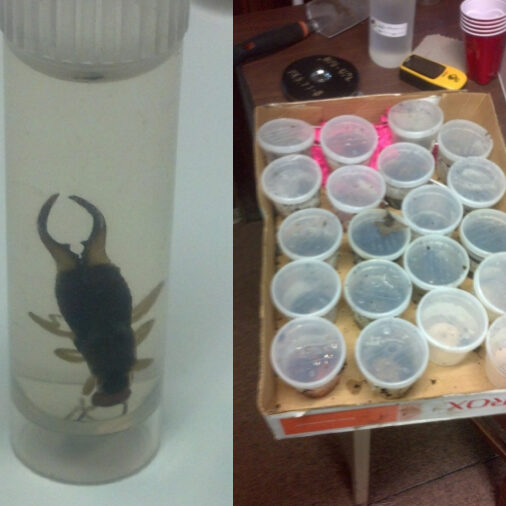Micah Jasny is a graduate student from the Nicholas School of the Environment at Duke University working this summer as an E.O. Wilson Biodiversity Foundation intern, as part of the ATBI/BioBlitz SWAT Team. His work is supported through a partnership with Discover Life in America. This summer he will try to discover new species to add to the park inventories in order to better understand park ecosystems and how to care for them. He also plans to help other scientists working in the park with their biodiversity surveys and scientific research. In the upcoming weeks, he will give weekly updates about his forays into the park and report back on his biodiversity research.
ATBI/BioBlitz SWAT Team: Week 4 in Great Smoky Mountains National Park
Preparing for the All Taxa Biodiversity Inventory (ATBI)
This week, I began preparations for my addition to the All Taxa Biodiversity Inventory (ATBI) here at the Great Smoky Mountains National Park. The purpose of an ATBI is to document all living species present within a defined area. The first ATBI in the U.S. started here in the park in 1977 and has involved hundreds of scientists and thousands of volunteers working to try and inventory the estimated 100,000 species present within the park boundaries. Currently, the ATBI efforts have helped to nearly double the number of known species in the park and have almost 1,000 species new to science have been discovered. E.O. Wilson pointed out that we live on a relatively unexplored planet. ATBIs encourage us to explore and discover the biodiversity that we don’t always notice, yet surrounds us everyday.
When I began this internship, I was given a list of priority groups that the park wanted to learn more about. After close to three decades of study, efforts to identify new species face two main hurdles. First, species that remain undiscovered today haven’t been recorded for a reason—they are hard to find! Many of the obscure species are microscopic or difficult to sample, but discovery is worth the effort. The other main hurdle is that taxonomists are a rare breed; finding someone able to identify tiny organisms down to a species level, given that there might be over a thousand different species worldwide, is a difficult task. Some samples may require large amounts of time and resources to accurately identify them and few experts have the time or the resources to spare.


That being said, I have embarked on a mission to inventory earwig species (Dermaptera) present within the Great Smoky Mountains National Park. While over 1,800 earwig species exist worldwide, there are just over 20 species recorded in North America. Earwigs are well-known garden pests and can be readily identified by a characteristic pair of cerci, which look like forceps or pincers at the tail end of the body and are used for defense. Earwigs are most active during the night and often hide in dark, cool areas during the day. Contrary to mythology, earwigs are not very harmful to humans; their pincers do not emit toxins and despite the scary appearance, they don’t even pinch with a great amount of pressure. Furthermore, the idea that earwigs frequently try to nest in ears (the reason for their name) is also almost completely unfounded.
After my initial research into earwig collection techniques, I have decided to use baited pit-fall traps for my study. Pitfall-traps are small containers that may or may not contain a bait to lure specimens into the trap and are buried in the ground so the top of the trap is at the same height as the soil. The problem with using baited pit-fall traps in a national park is that bears or other large species may also be attracted to the traps and become used to feeding from them. It is the park’s rule that if any pitfall traps in a location appear disturbed, all sampling within a mile of the location needs to be halted in order to prevent impacting other wildlife.
For this reason, I am testing several different baits/solutions to try and attract/trap earwigs. Based on a literature review and past ATBI methodology, I am testing soapy water, soy sauce, vegetable oil, non-toxic anti-freeze, and ethanol baited pit-fall traps in one location. After 3-4 days, I will check the traps and see which bait worked best to attract earwigs. I will then place 15-20 pitfall traps at 6 different locations around the park and check/replace the traps once a week. As for the identification of the species of specimens collected, I have emailed several experts and am waiting on responses. Depending on what the experts say, I may use online, crowd-sourced taxonomic identification websites such as iNaturalist to assist me with identification, as well as taxonomic keys. Whatever happens, I’m sure it will be an interesting experiment and a great learning experience!
—Micah Jasny

